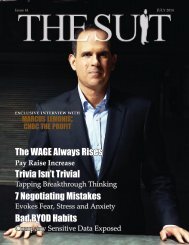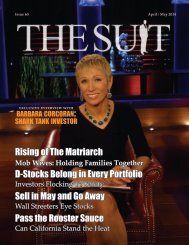Kayla Tausche CNBC
The arrival of January seems to bring out the list-making in the media. There are reviews of the previous year and predictions for the one we are now in. Publications commonly create a list of Top 40 Business People that are under the age of 40 as top entrepreneur’s to watch for the upcoming year. It used to be that 40 was the target for career establishment. Not anymore. In today’s aggressive market place, a long track record of success prior to age 30 is not uncommon. Credit technology is the empowerment of the Millennials. The reality is that the age bracket in which 30 is considered old, don’t just have extensive resumes – they have already formed in irreversible impact. That’s why The Suit Magazine opted to highlight six of these movers and shakers in our first edition for 2015. As expected, our list contains success stories from social media. There is no denying the changes and questions the emergence of social media brings to our world. Yet, our list goes further.
The arrival of January seems to bring out the list-making in the media. There are reviews of the previous year and predictions for the one we are now in. Publications commonly create a list of Top 40 Business People that are under the age of 40 as top entrepreneur’s to watch for the upcoming year. It used to be that 40 was the target for career establishment. Not anymore. In today’s aggressive market place, a long track record of success prior to age 30 is not uncommon. Credit technology is the empowerment of the Millennials. The reality is that the age bracket in which 30 is considered old, don’t just have extensive resumes – they have already formed in irreversible impact. That’s why The Suit Magazine opted to highlight six of these movers and shakers in our first edition for 2015. As expected, our list contains success stories from social media. There is no denying the changes and questions the emergence of social media brings to our world. Yet, our list goes further.
Create successful ePaper yourself
Turn your PDF publications into a flip-book with our unique Google optimized e-Paper software.
y a. judy marie scinyamagness<br />
velthuizen<br />
Buying and Repairing Broken and<br />
Underperforming Businesses<br />
Most private equity financing firms retain the businesses they invest in only until enough improvements<br />
have been made for the firm to turn a respectable profit when the business is sold. Yet a handful of PE<br />
firms are opting for a different approach. In a trend being cultivated by a much smaller number of PE<br />
firms, distressed businesses purchased with the goal of restoration to profitability are being kept for significant<br />
periods of time – sometimes indefinitely – since a financial harvest different from the standard<br />
“return on sale” is sought by investors with rather long-term goals.<br />
Industrial Renaissance (IR) is one of these firms opting to<br />
keep, rather than sell, the struggling or underperforming<br />
businesses they acquire. Eric Hamburg, the firm’s<br />
president explains.<br />
“It is difficult to build a significant business that is running<br />
well. This can take plenty of money and many years,”<br />
Hamburg said. “Once that has finally been done, it is our<br />
preference to continue to own that business and continue<br />
to work with it.”<br />
In fact, Hamburg said that his goal is to make such a<br />
marked improvement in the working and profitability of<br />
a struggling business his firm acquires, that selling it just<br />
would not even be considered an option.<br />
IR’s website provides an extensive list of characteristics<br />
sought in a potential purchase. Fifteen descriptions make<br />
up this list, ranging from the absence of a management<br />
leader, a liquidity-constrained balance sheet, little or no<br />
earnings, long lead times, slow revenue growth, and a high<br />
cost and overhead structure. Other characteristics include<br />
fractured relationships with lenders, high inventory levels<br />
with low inventory turnovers and a documented need for<br />
operational improvements.<br />
“Our list is a bit lengthy,” Hamburg admits. “Yet, the<br />
more of those check marks that a business hits, the more<br />
we tend to like them as a potential investment purchase.<br />
This makes us different from other investment firms that<br />
look at historical performance as a gauge to judge future<br />
performance. We tend to look forward with a business –<br />
and look toward what can be created with it.”<br />
Perhaps the most important characteristic on that list is<br />
a quality product offering the ability – proven or unproven<br />
– to capture market share. If a firm has that, Hamburg’s<br />
interest is piqued. Add positioning in an industry with consolidation<br />
potential, and expect that Hamburg and IR are<br />
taking a good long look.<br />
While he regularly approaches a potential investment as<br />
an interested buyer, at other times Hamburg approaches<br />
from the perspective of a CEO looking to take over and run<br />
THE SUIT MAGAZINE - JAN 2015










